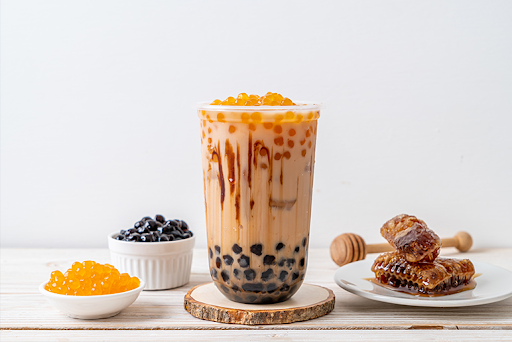What is bubble tea and how is it made?
Catherine Todd. 08/28/2021

Bubble tea has quickly become a global phenomenon since its invention in Taichung, Taiwan in the 1980s. A refreshing mix of cool tea and sweet spheres of chewy boba, bubble tea comes in many flavors and forms. Drinks range from the traditional milk tea topped with boba to extravagant fruit-flavored teas or smoothies filled with chunks of pudding, jellies, and popping bubbles.
There are many different flavors of tea, but all tea leaves come from the Camellia sinensis plant. Classic bubble tea uses black tea, which has a malty taste that is created by rolling and bruising Camellia sinensis assamica leaves. This maximizes the amount of oxidation, a chemical process where oxygen reacts with the natural flavoring compounds in the leaves that the leaves go through. On the other hand, milder teas such as green tea are created by heating and drying Camellia sinensis assamica leaves as soon as they are harvested to prevent oxidation and preserve their fresh taste. Hence, tea-making follows this general concept: smaller leaves and less oxidation result in lighter-flavored teas, while larger leaves and more oxidation create stronger-flavored teas.
Boba is the special ingredient that distinguishes bubble tea from others. The chewy morsels are made from a combination of tapioca flour, water, and brown sugar. The tapioca flour consists solely of starch, and when mixed with hot water, it swells and breaks apart, forming a water-retaining network that forms the solid gel-like texture of boba. This process is called starch gelatinization. Modern chefs have created a new type of boba with molecular gastronomy, called popping boba. This topping is exactly what it sounds like: chewy spheres that pop in your mouth, releasing a small burst of fruit juice. To create this popping effect, a small quantity of powdered sodium alginate is mixed with the fruit juice and then dripped into a bowl that contains a solution of calcium chloride. This forms small bubbles in the liquid that have a layer of thin skin composed primarily of seaweed extract. However, boba and its siblings are not the only toppings available today - chunks of pudding, jelly, red beans, and cream caps are available as well
To tie it all together, flavoring is needed. The first bubble tea used brown sugar, but now white sugar is also used. All sugar comes from the sugarcane plant: Saccharum officinarum. Sugarcane juice is extracted from the stalk of the plant, then purified and heated, forming a brown, concentrated syrup called molasses. Next, the molasses is centrifuged to produce brown sugar crystals, which are then ready for packaging. If white sugar is desired, the brown sugar is further processed to remove all remnants of molasses. Because brown sugar contains more molasses, it is denser, less sweet, and more expensive than white sugar. While homemade bubble teas usually use brown sugar to pertain to tradition, most bubble teas sold in stores use white sugar. As such, though a properly created cup of bubble tea may seem flawless and simple, there is actually a lot of work that goes into making it, i.e. processing the tea, making the boba, and flavoring and customizing it all to each person’s desires.
What began as a Taiwanese street vendor product has now blossomed into one of the most well-known drinks in the world. It has even become a popular staple in America with the help of chain stores such as Kung Fu Tea and Kokee Tea. These modern stores continue to innovate, creating new flavors of tea and types of toppings, all while sticking to the essence of Taiwanese culture that made it all possible. Sample a region’s bubble tea, and you will be able to glimpse the culture of the people living there. One sip of the traditional milk bubble tea will transport you to a Taiwanese night market, teeming with bubble tea vendors and hundreds of other food stands waiting for you to explore them. One sip of a milk cap deluxe bubble tea featuring brown sugar syrup streaks and thick, frothy cream, will drop you into one of Taiwan’s deluxe malls, bustling with energy and class. Whether you favor heartwarming, homemade bubble teas or lavish remixes, you will find yourself taking sip after sip of the wonderful drink called bubble tea.
Cover Photo: (The Spruce Eats)
